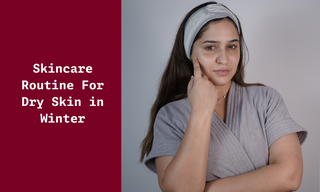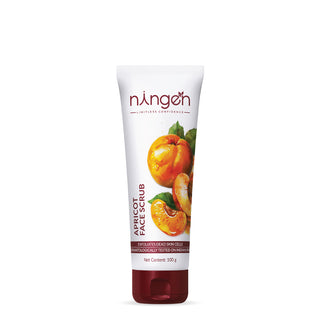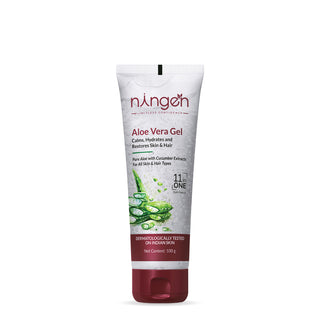Welcome to the Winter Glow Guide, where we decode the art of skincare tailored for your dry skin during the chilly months. As winter whispers its frosty tales, your skin seeks a comforting ritual.
Say goodbye to the woes of flaky discomfort and hello to a nourishing skincare routine. In this easy-to-follow blog, we unravel the secrets behind a winter skincare regimen designed to bring radiance to your complexion. So, grab a cozy blanket, settle in, and let’s embark on a journey to a skincare routine for dry skin in winter & keep your skin happily hydrated and luminous throughout the winter season. Winter is here, but dry skin doesn't stand a chance!
Causes of Dry Skin in Winter
Before we dive into the skincare routine for dry skin in winter, let's understand why your skin gets dry in the winter. Cold air outdoors and indoor heating can strip your skin of its natural moisture. The lack of humidity in the air further exacerbates the problem. As a result, your skin feels tight, and itchy, and might even develop flaky patches.
Symptoms of Dry Skin in Winter
Winter's chill can leave your skin feeling dry and tight. Signs of dry skin include flakiness, redness, and a rough texture. You might notice itchiness, especially after a hot shower. Cracks or fine lines may appear, and your skin may feel more sensitive. Lips can become dry and chapped. If you see these symptoms, it's your skin telling you it needs extra care. Keep it hydrated with a rich moisturizer, avoid hot water, and stay cozy in winter layers. Embrace these simple steps, and your skin will thank you with a healthy, happy glow all season long.
Complications of Dry Skin in Winter
Winter's dry air can bring complications to your skin. Prolonged dryness may lead to eczema flare-ups, causing redness and intense itching. Cracks in the skin can become susceptible to infections, risking inflammation. Severe dryness may accelerate the aging process, accentuating fine lines. Persistent dry skin can even worsen conditions like psoriasis. Additionally, dry, chapped lips are common, causing discomfort.
To combat these complications, prioritize deep hydration, avoid prolonged hot showers, and use a humidifier to add moisture to the air. By addressing dry skin promptly, you can mitigate complications and keep your skin healthy and resilient during the winter months.
Skincare Routine For Dry Skin in Winter
Step 1: Gentle Cleansing
Choose a Mild Cleanser: Start your skincare routine with a gentle, hydrating cleanser. Look for a product that doesn't strip your skin of its natural oils. Avoid harsh, astringent cleansers that can worsen dryness.
Wash with Lukewarm Water: While it's tempting to take hot showers in winter, hot water can be harsh on your skin. Use lukewarm water to cleanse your face and body to avoid excess dryness.
Pat Dry, Don't Rub: After cleansing, gently pat your skin dry with a soft towel rather than rubbing vigorously. This will help retain some moisture on your skin.
Ningen has a variety of face wash and cleansing milk that are packed with natural ingredients and safe for the skin. Select according to your skin type to get the best results.
Step 2: Exfoliation (Not Too Often)
Exfoliating is essential to remove dead skin cells and encourage cell turnover, but during the winter, you should be cautious.
Choose a Gentle Exfoliator: Opt for a mild exfoliator that suits your skin type. Exfoliate 1-2 times a week, as over-exfoliating can exacerbate dryness.
Orange and Apricot Scrub is enriched with Orange, Apricot, Bamboo, and Blueberry that deep cleanses, nourishes, and gently removes tan and dead skin cells, revealing smoother, brighter skin. It doesn’t strip moisture from your skin at all.
You can use infused with small walnut particles, it gently exfoliates, revealing smoother skin than I expected. The aroma is pleasant, and it doesn't strip moisture. My skin looks clean and bright.
Step 3: Hydration is Key
Moisturizing is the cornerstone of your winter skincare routine.
Hydrating Moisturizer: Invest in a rich, hydrating moisturizer that contains ingredients like hyaluronic acid, glycerin, or ceramides. These ingredients lock in moisture and create a protective barrier.
Ningen has a range of hydrating moisturizers that are enriched with naturally hydrating ingredients not only highly effective but also safe for skin. You can choose according to your skin type for the best results.
Apply After Cleansing: Apply your moisturizer while your skin is still slightly damp after cleansing. This locks in the moisture.
Lip Balm: Don't forget your lips! Use a nourishing lip balm to keep your lips from getting chapped.
Step 4: Sunscreen is a Must
Just because it's winter doesn't mean you can skip sunscreen.
Broad-Spectrum Sunscreen: Choose a broad-spectrum sunscreen with at least SPF 30 to protect your skin from UV rays. Apply it in the morning, even on cloudy days.
Step 5: Humidify Your Indoor Space
Use a Humidifier: Investing in a humidifier for your home can do wonders for your skin. It adds moisture to the dry indoor air, helping to prevent excessive drying of your skin.
Step 6: Opt for Soothing Ingredients
Look for Ingredients like Aloe Vera and Oatmeal: Skincare products with soothing ingredients like aloe vera, oatmeal, and chamomile can calm irritated, dry skin.
Avoid Products with Alcohol and Fragrances: Alcohol-based products can be harsh and dry. Fragrances, especially in skincare, can irritate sensitive skin.
Step 7: Hydrate from Within
Drink Plenty of Water: Staying hydrated from the inside out is just as important. Drink enough water to keep your skin and body hydrated.
Consume Moisturizing Foods: Incorporate foods rich in essential fatty acids, like salmon, avocados, and nuts, into your diet. They help maintain your skin's natural lipid barrier.
Step 8: Don't Overheat Indoors
Limit Heated Spaces: Excessive exposure to heated indoor environments can dehydrate your skin. Try to find a balance between warmth and humidity.
Wear Layers: Dress in layers to regulate your body temperature and avoid overheating, which can lead to excessive sweating and further dryness.
Step 9: Extra TLC for Hands and Feet
Hand Cream: Keep a nourishing hand cream handy to prevent your hands from cracking. Apply it after washing your hands and before bedtime.
Foot Care: Don't forget about your feet! Use a moisturizing foot cream and wear cozy socks to keep your feet soft and supple.
Marigold Foot Cream helps to heal and repair cracked, dry, and rough skin. Enriched with the goodness of marigolds, pomegranates, and coffee, this cream deeply moisturizes and softens the skin, leaving it smooth and supple.
Step 10: Stay Comfortable
Wear Comfortable Fabrics: Wear soft, breathable fabrics like cotton to prevent skin irritation and itching.
Avoid Excessive Heat: Hot baths and showers may feel great, but they can strip your skin of natural oils. Opt for shorter, warm showers instead.
Step 11: Consult a Dermatologist
If your dry skin is persistent, painful, or accompanied by unusual symptoms, it's a good idea to consult a dermatologist. They can provide personalized recommendations and treatments for your specific skin concerns.
Incorporating these steps into your winter skincare routine can make a significant difference in how your skin looks and feels during the colder months. Remember that consistency is key, and what works for one person may not work for another. So, take the time to find the right products and routines that suit your unique skin needs.
Conclusion
I hope you found this article on the skincare routine for dry skin in winter helpful. Winter inter skincare doesn't have to be complicated. With a few adjustments and the right products, you can keep your skin glowing and hydrated, even in the coldest months. So, embrace the winter wonderland with confidence and radiant, moisturized skin.










